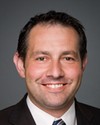Ladies and gentlemen, good morning.
It's my pleasure to be given this opportunity to speak to you today about the investment, preparation, and strategy that Bobsleigh Canada Skeleton has taken on behalf of Canada to ready our team for the Olympic Winter Games in Sochi. I thank you for this opportunity, and appreciate your interest and support of Canadian athletes and their coaches.
It seems only appropriate to start the status of our preparations for Sochi with the results from last weekend's World Cup held in Calgary. Kaillie Humphries and Heather Moyse dominated the women's two-man bobsleigh, capturing gold by over half a second from their closest rival. Chris Spring and Jesse Lumsden captured bronze in the two-man. Eleven Canadian athletes and teams competed in skeleton bobsleigh. All but one finished in the top ten.
Our mission is simple. BCS creates, nurtures, and supports world and Olympic champions. BCS believes strongly that the important values that underscore any sustainable community are described by what we call INSPIRE: integrity, national pride, sportsmanship, professional, innovation, respect, and excellence.
Our vision is clear. BCS will lead our entire Canadian community in the pursuit of becoming and sustaining the mantle of the leading bobsleigh and skeleton nation in the world. Kaillie Humphries, Jon Montgomery, Helen Upperton, Pierre Lueders, Lyndon Rush: we produce results.
While predominantly concentrated in the west at WinSport and the Whistler Sliding Centre, our champions hail from all provinces. In fact, we have representation from 10 of Canada's provinces and territories on our senior national team. The singular, clear, and unwavering focus of BCS is manifested in our provincial sections in British Columbia, Alberta, and Ontario.
In terms of investment in our success, our mission and vision could not be reached without the critical investment of Sport Canada, Own the Podium, and the Canadian Olympic Committee. Our boutique sport is geocentric by the nature of access to required facilities. We receive about 85% of our operating funds from these partners. We supplement those dollars with sponsorship revenues from corporate Canada, and 90% of our funds are directed towards our athletes and our technical programs.
I'll turn now to the preparations for success. In Vancouver, thirty-nine one-hundredths of a second was the margin between getting a medal to not being on the podium in bobsleigh. In skeleton, Jon Montgomery's walk of fame was the result of being seven one-hundredths of a second better than everyone else. We don't have 60 minutes to adjust. Every adjustment is critical at 156 kilometres an hour. Preparation is our key.
Our athletes are preparing for Sochi with a prediction of three medals. We have been in Sochi twice with all of our top athletes. Last year Kaillie Humphries repeated as world champion and medalled in all world cups, including six golds and a bronze at the World Cup in Sochi. Lyndon Rush ranked number one in the world in the two-man. Sarah Reid finished with the world championship bronze medal in skeleton.
Equipment is essential in our sport. We have partnered with a Dutch sled manufacturer, and we feel we have the fastest bobsleighs in the world. We have partnered with SAIT in Calgary, and are on the cusp of developing world-class skeleton sleds. Supported by Own the Podium, we have invested over $1 million in bobsleigh development in the years since Vancouver.
On-ice training and competitive opportunities in Canada's legacy facilities are key to our ability to race and win on any type of track in the world. The federal government's belief and investment in Calgary in 1988 and Vancouver in 2010 has been the cornerstone of Bobsleigh Canada's ability to develop world and Olympic champions.
Our access to provincially and federally supported training facilities like WinSport and Whistler Sliding Centre allows our athletes to train for specific track conditions and landscapes, as these two tracks are technically very different. These differences are a critical advantage. Pilots learn to drive and adapt to different curvatures and pressures. Brakemen learn to push short for a steep-pitch start and long for a gradual slope. We have significant knowledge for the testing and adjustments of our sleds and runners for both bobsleigh and skeleton.
All across the country, our athletes access the Canadian sport institutes. While we predominantly train in Calgary, our athletes do come from across the country and always utilize the opportunities with the CSI. This partnership with the CSI ensures our athletes get world-class sports science, medical services, and coaching services in their daily training environment, giving us the margin of victory we need.
With respect to our strategy for success, our strategy starts with an ongoing search for the next Jon Montgomery or Kaillie Humphries.Our long-term athlete development pathway in bobsleigh is a little different from the playground-to-podium pathways of most other sports. We utilize the partnerships and services of the Canadian sport institutes, fellow national sport federations such as track and field, rugby, and football, and Canadian Interuniversity Sport.
Most recently, we have had success recruiting athletes from the Canadian Football League, with the acquisition of Jesse Lumsden from Calgary, Sam Giguère from Hamilton, and Jean-Nicolas Carriere from Montreal.
For skeleton, we use the more traditional model in concert with luge, where Discover Skeleton programs happen in Alberta and British Columbia with young athletes, but we also capture older second-sport athletes as well. The sport is extreme, and this intrigues those athletes who live for the adrenalin rush.
The two acquisition and retention strategies bring the PSOs and the NSF into alignment.
I've already discussed the preparation and polish.
Finally, we host national and international competitions in Canada's legacy facilities. Major competitions generate excitement for our sports. They become a critical recruiting tool. They are essential for the exposure of our corporate and government partners. We test our Canadian athletes against the best in the world on home soil. There is no better feeling than winning at home, and this is why sport is essential to the fabric of Canada. Vancouver 2010 proved that.
We simply could not host these types of competitions without the availability of grants through provincial and federal agencies. I thank the federal government sincerely for their ongoing and significant support of Canadian athletes and coaches.
I look forward to continuing this conversation with the committee.
Thank you.


